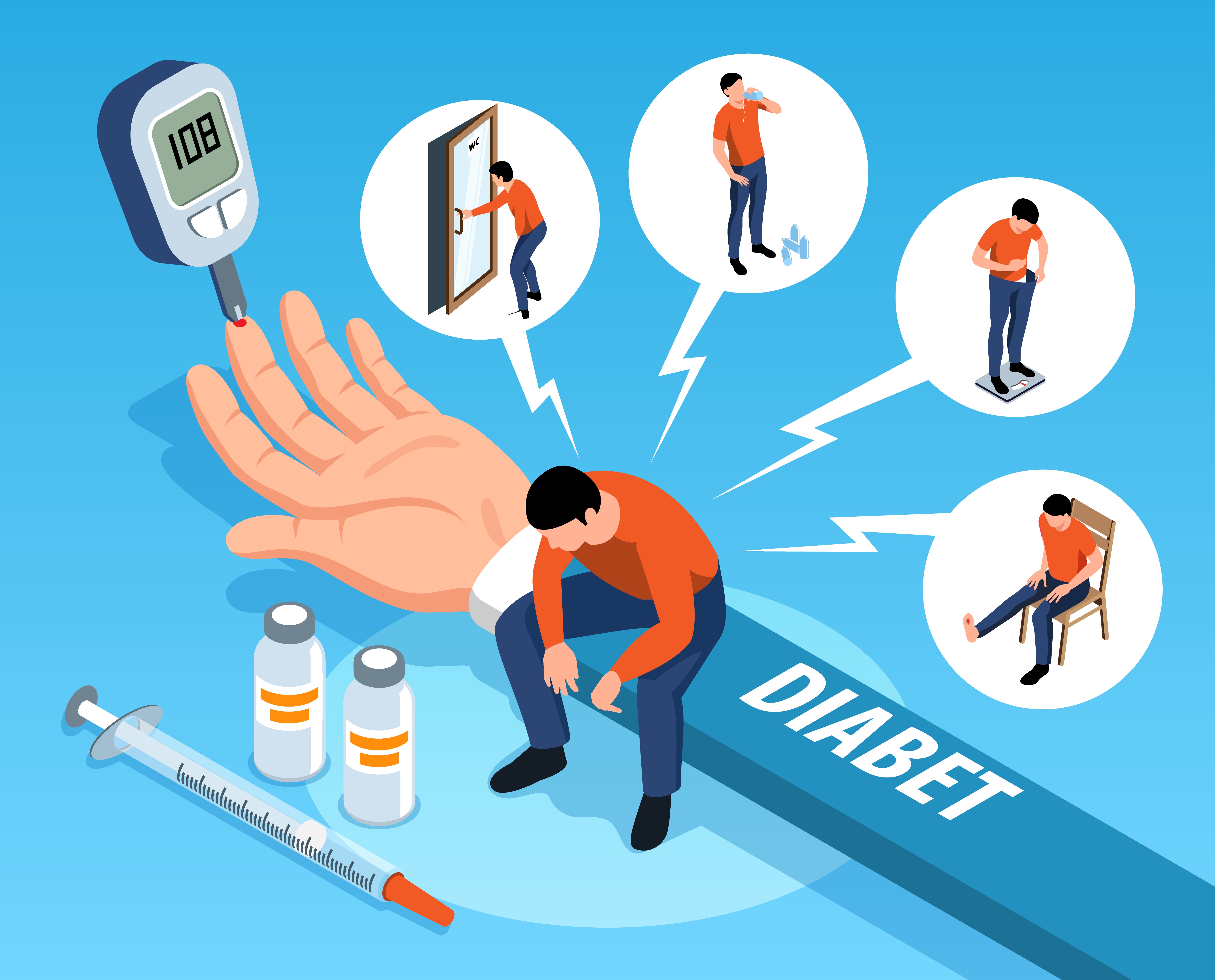Blog Posts & Blog Archives
All Blogs / health-and-safety
Understanding Diabetes Symptoms Causes and Treatments
Learn about diabetes, its symptoms, causes, risk factors, and treatments. Discover how to manage this chronic condition effectively to maintain your health.
Tuesday, September 3, 2024
Understanding Diabetes Symptoms Causes and Treatments
Diabetes, often known as diabetes mellitus, is a chronic health condition that affects millions of people worldwide. It occurs when the body either fails to create enough insulin or is unable to use the insulin it does make properly, leading to elevated blood glucose (sugar) levels. Diabetes, if not controlled effectively, can lead to major health complications affecting the heart, kidneys, eyes, and other organs. This blog will explore the symptoms of diabetes, its causes, risk factors, and the available treatments to manage the condition effectively. Diabetes, commonly referred to as diabetes mellitus, is a long-term health condition that impacts millions globally. It arises when the body either fails to produce sufficient insulin or cannot effectively utilize the insulin it does create, resulting in high blood glucose (sugar) levels. If left unmanaged, diabetes can lead to serious health issues that affect the heart, kidneys, eyes, and other vital organs. There are three main types of diabetes: Type 1 Diabetes: This syndrome occurs when the immune system erroneously targets insulin-producing cells in the pancreas, resulting in little or no insulin production. Type 1 diabetes is most typically diagnosed in children and young adults, and those who have it will require insulin therapy for the rest of their lives. Type 2 Diabetes: The most common form, Type 2 diabetes, occurs when the body becomes resistant to insulin or the pancreas fails to produce enough insulin. This type is often linked to lifestyle factors such as poor diet and lack of exercise, but genetics also play a role. Gestational Diabetes: This type develops during pregnancy and can affect both mother and child. It usually resolves after delivery, but it increases the risk of developing Type 2 diabetes later in life. Recognizing the symptoms of diabetes early can help with timely diagnosis and treatment. Symptoms can develop gradually, and some individuals with Type 2 diabetes may not even realize they have the condition. Here are some typical signs you should be aware of. ● Frequent urination: High blood sugar levels cause excess glucose to be excreted through urine, leading to increased urination. ● Excessive thirst: The body loses fluids due to frequent urination, which triggers dehydration and persistent thirst. ● Extreme hunger: Despite eating, people with diabetes may feel hungry because their cells aren't absorbing glucose effectively. ● Fatigue: When the body's cells don't get enough glucose, it can result in constant tiredness or lack of energy. ● Blurred vision: High blood sugar can affect the eyes, causing vision problems. ● Slow healing of wounds: Cuts and bruises may take longer to heal due to poor blood circulation and high blood sugar. ● Unexplained weight loss: People with Type 1 diabetes often experience significant weight loss despite eating more because the body burns fat and muscle for energy. Understanding the origins of diabetes is essential for effectively managing and preventing the condition. Type 1 diabetes is mostly an autoimmune disorder. In this situation, the immune system incorrectly targets and kills insulin-producing beta cells in the pancreas. This damage is thought to be influenced by both hereditary and environmental factors, while the precise cause is yet unknown. Type 2 diabetes results from insulin resistance, where the body's cells do not respond to insulin properly, and eventually, the pancreas can't keep up with the demand for insulin production. The primary causes include: ● Obesity: Excess body fat, especially in the abdomen, increases the chance of developing insulin resistance. ● Genetics: A family history of diabetes increases the likelihood of developing the condition. ● Lack of physical activity: Inactivity contributes to weight gain and insulin resistance. Gestational diabetes develops during pregnancy due to hormonal changes that make the body more resistant to insulin. If the pancreas cannot produce enough insulin to overcome this resistance, blood sugar levels rise. There are several factors that can elevate an individual's risk of developing diabetes. While certain risk factors, like genetics, are beyond our control, many can be influenced by making lifestyle adjustments. ● Family history: Having a parent or sibling with diabetes raises your risk. ● Obesity: Being overweight, especially carrying excess fat around the abdomen, increases the risk of insulin resistance. ● Inactivity: A sedentary lifestyle makes it harder for the body to manage blood sugar effectively. ● Age: The risk of Type 2 diabetes increases as you age, particularly after age 45. ● Ethnicity: People of certain ethnic backgrounds, including African American, Hispanic, Native American, and Asian American, are at a higher risk of developing Type 2 diabetes. ● High blood pressure: Hypertension is a common risk factor for diabetes. ● Gestational diabetes: Women who experience gestational diabetes are at a higher risk of developing Type 2 diabetes later in life. While there is currently no cure for diabetes, it can be managed effectively through a mix of lifestyle changes, medications, and sometimes insulin therapy. 1. Lifestyle Changes For individuals with Type 2 diabetes or prediabetes, lifestyle changes are often the first line of defense. These include: ● Healthy eating: A balanced diet rich in whole grains, lean proteins, fruits, and vegetables can help manage blood sugar levels. ● Regular exercise: Physical activity helps the body use insulin more efficiently and can lead to weight loss, improving blood sugar control. ● Weight management: Even little weight loss can significantly improve insulin sensitivity. ● Monitoring blood sugar: Regularly checking blood sugar levels helps individuals manage their condition effectively. For some people, implementing lifestyle modifications may not be enough to properly control diabetes. There are various drugs available that can help manage blood sugar levels, including: ● Metformin: A common medication that reduces glucose production in the liver and improves insulin sensitivity. ● SGLT2 inhibitors: These drugs assist the kidneys in removing excess glucose from the body via urine. A CGM device continuously tracks glucose levels throughout the day and night, providing real-time data. This technology is especially helpful for people who struggle with maintaining stable blood sugar levels. For individuals at risk of developing Type 2 diabetes, certain lifestyle modifications can significantly reduce the likelihood of the condition: ● Maintain a healthy weight: A balanced diet and regular exercise can help prevent insulin resistance and weight gain. ● Increase physical activity: Aim for at least 30 minutes of moderate physical activity most days of the week. ● Eat a balanced diet: Concentrate on whole meals, fiber-rich fruits and vegetables, and lean meats, while avoiding processed carbs and sugary foods. ● Quit smoking: Smoking boosts your risk of getting diabetes and associated complications. ● Manage stress: Chronic stress can affect blood sugar levels, so it's essential to find effective ways to manage it. Diabetes mellitus is a complex and widespread condition that can significantly impact a person’s quality of life if not managed properly. By understanding the symptoms of diabetes, its causes, and the available treatments, individuals can take control of their health and minimise the risks of complications. While some risk factors are beyond control, adopting a healthy lifestyle, staying active, and monitoring blood sugar levels can go a long way in preventing or managing diabetes. What is Diabetes Mellitus?
Symptoms of Diabetes
Causes of Diabetes
1. Type 1 Diabetes Causes
2. Type 2 Diabetes Causes
3. Gestational Diabetes Causes
Risk Factors for Diabetes
Treatment and Management of Diabetes
2. Medications
4. Continuous Glucose Monitoring (CGM)
Preventing Diabetes
Conclusion:
Related Blogs
Reasons Why Workplace Safety Is Important
Discover why workplace safety is important with five compelling reasons. Ensure the well-being of employees and boost productivity.
By WelinkJobs | Saturday, May 6, 2023
Mastering the Art of Sleep Hygiene: 5 Ways to Healthy Sleep Hygiene Habits
Discover five simple yet effective ways to master the art of healthy sleep hygiene habits and improve your overall well-being. Prioritize your healthy sleep hab
By WelinkJobs | Tuesday, July 4, 2023



